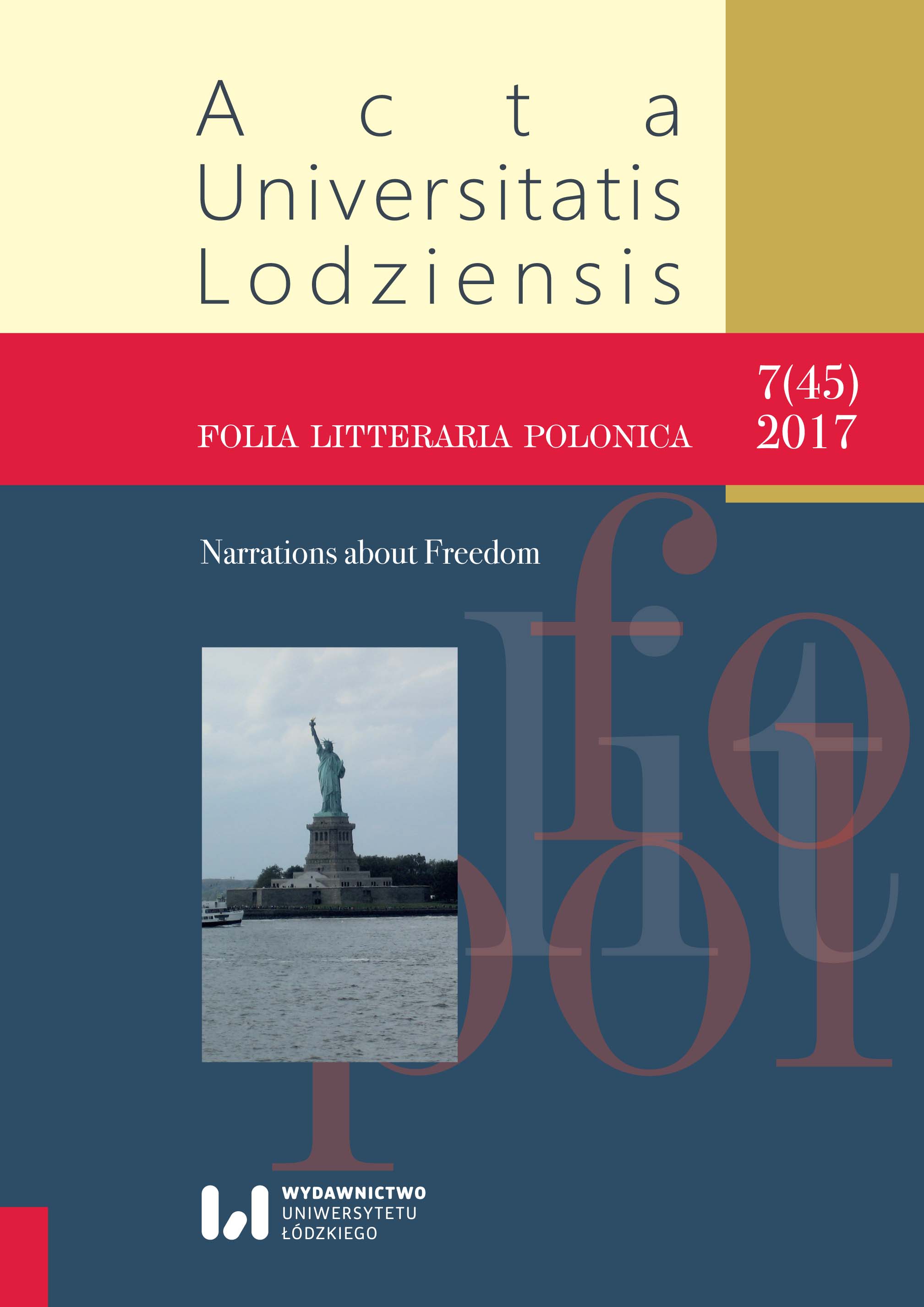Parables of Un-freedom: Novels about the Spanish Inquisition in post-1956 People’s Poland
DOI:
https://doi.org/10.18778/1505-9057.45.09Keywords:
Censorship, Inquisition, Poland, medieval, Spain, control, silence, the Thaw, independent publishing, underground, historical novel, Polish literature, AesopianAbstract
The article examines three post-1956 novels ostensibly about the Spanish Inquisition’s activities in Spain at the end of the fifteenth century: Jerzy Andrzejewski’s Ciemności kryją ziemię (The Inquisitors, 1957), Julian Stryjkowski’s Przybysz z Narbony (1978), and Jozef Cepik’s Torquemada (1986). These works are placed in a number of broader contexts: the uses of the historical novel in Poland; post-war Polish censorship discourse about the use of historical analogy to address current social and political problems, a practice which the political authorities sought to restrict; the contemporary critical reception where reviews of each novel are seen as articulating the novels’ fundamental concerns albeit subject to the same censorship restrictions; and ultimately the longestablished tradition of Aesopian writing within Polish literature. The analysis demonstrates the expansion of the space for critical public expression particularly in the Thaw years of 1956-57, and its contraction over time up to the mid-1970s. The rise of an independent publishing network at that point paradoxically both facilitates a more open discussion of the potential meanings of literary texts but equally has to observe censorship proprieties to avoid exposing officially published authors to political sanctions. With the growth of underground publishing, the Spanish Inquisition theme gradually declines in relevance, reflected by the critical marginalisation of Cepik’s novel. Ultimately, the article positions the trend within Macherey’s theory of significant silences within literary works, which permits a refinement of the historically contingent screen and marker that have typically defined Aesopian works. The article presents, with their English translations, hitherto unpublished documents from the Polish Party and Censorship archives, including examples of work confiscated by the censors.
Downloads
References
Andrzejewski Jerzy, Ciemności kryją ziemię, PIW, Warsaw 1957.
Google Scholar
Andrzejewski Jerzy, The Inquisitors, trans. Konrad Syrop, Weidenfeld and Nicolson, London 1960.
Google Scholar
Augustine, On Baptism, 7 39:77, PL, 43, col. 257.
Google Scholar
Bates John, “Cenzura wobec problemu niemieckiego w literaturze”, in: Presja i ekspresja: Zjazd Szczecinski i Socrealizm, Danuta Dąbrowska and Piotr Michałowski (eds), Wydawnictwo Naukowe Uniwersytetu Szczecinskiego, Szczecin 2002, pp. 79–92.
Google Scholar
Blyum Arlen, A Self-Administered Poison: The System and Functions of Soviet Censorship, trans. I.P. Foote, University Humanities Research Centre, University of Oxford: Legenda Special Lecture Series 5, 2003.
Google Scholar
Bocheński Jacek, Krwawe specjały włoskie, Biblioteka Gazety Wyborczej, Warsaw 2009.
Google Scholar
Bourdieu Pierre, “Censorship and the Imposition of Form”, in Language and Symbolic Power, ed. John B. Thompson; trans. Gino Raymond and Matthew Adamson, Polity, Cambridge 2003, pp. 137–159.
Google Scholar
Brown Wendy, “Freedom’s Silences”, in: Censorship and Silencing: Practices of Cultural Regulation, Robert C. Post (ed.), The Getty Institute for the History of Art and the Humanities, Los Angeles 1998, pp. 313–327.
Google Scholar
Budrowska Kamila, Literatura i pisarze wobec cenzury PRL 1948–1958, Wydawnictwo Uniwersytetu w Białymstoku, Białystok 2009.
Google Scholar
Burek Tomasz, “Zapomniana literatura polskiego Października”, in: idem, Żadnych marzeń, Polonia, London 1986, pp. 53–73.
Google Scholar
Cepik Jozef, Torquemada, Wydawnictwo Poznańskie, Poznan 1986.
Google Scholar
Goldstein Robert Justin, “Aesopian Writing”, in: Censorship: A World Encyclopedia, Derek Jones (ed.), Fitzroy Dearborn, London–Chicago 2001, pp. 16–17.
Google Scholar
Groot Jerome de, The Historical Novel, Routledge, London and New York 2010.
Google Scholar
Herbert Zbigniew, “Obrona Templariuszy” [Defence of the Templars], in: idem, Barbarzyńca w ogrodzie, Czytelnik, Warsaw 1964.
Google Scholar
Kołakowski Leszek, Towards a Marxist Humanism: Essays on the Left Today, trans. Jane Zielonko Peel, Grove, New York 1968, pp. 9–37.
Google Scholar
Kras Paweł, Husyci w piętnastowiecznej Polsce, Towarzystwo Naukowe KUL, Lublin 1998.
Google Scholar
Loseff Lev, On the Beneficence of Censorship. Aesopian Language in Modern Russian Literature, Verlag Otto Sagner, Munich 1984.
Google Scholar
Ładyka Jerzy, “Literatura i polityka”, Nowe Drogi 1985, issue 7, pp. 154–162.
Google Scholar
Macherey Pierre, A Theory of Literary Production, trans. Geoffrey Wall, Routledge, London–New York 2006.
Google Scholar
Mezinárodní ohlas Husitství, Josef Maček (ed.), Nakl. Československé akademie věd, Prague 1958.
Google Scholar
Misior Paweł, Ja, Tomasz Strzyżewski. O cenzurze i cenzorach, Léon Bonnet, Cracow 1997.
Google Scholar
Patterson Annabel, Censorship and Interpretation: The Conditions of Writing and Reading in Early Modern England, University of Wisconsin Press, Madison, Wisconsin 1991 [original edn 1984].
Google Scholar
Reifarth Gert, Philip Morrissey, “Aesopic Voices: A Foreword”, in: Aesopic Voices. Reframing Truth through Concealed Ways of Presentation in the 20th and 21st Centuries, Reifarth and Morrissey (ed.), Cambridge Scholars Publishing, Newcastle upon Tyne 2011, pp. 1–12 (p. 3); http://www.c-s-p.org/flyers/978-1-4438-3443-8-sample.pdf (accessed on 15.10.2012).
Google Scholar
Riffaterre Michael, Semiotics of Poetry, Methuen, London 1978.
Google Scholar
Romek Zbigniew, Cenzura a nauka historyczna w Polsce 1944–1970, Wydawnictwo Neriton, Warsaw 2010.
Google Scholar
Rupnik Jacques, The Other Europe. Part 1. Channel 4. 1987.
Google Scholar
Schreiber Jürgen, Jerzy Andrzejewskis Roman ‘Ciemości kryją ziemię’ und die Darstellung der spanischen Inquisition in Werken der fiktionalem Literatur, Otto Sagner, München 1981.
Google Scholar
Skarga Piotr, Kazania sejmowe (Sermons to the Sejm, 1597); http://staropolska.pl/ang/renaissance/skarga.php3 (accessed on 11.10.2012).
Google Scholar
Smulski Jerzy, “Jak niewyrażalne staje się wyrażalne? O języku ezopowym w prozie polskiej lat pięćdziesiątych”, in: Literatura wobec niewyrażalnego, Włodzimierz Bolecki and Erazm Kuźma (eds.), PAN, Warsaw 1998, pp. 145–164.
Google Scholar
Stryjkowski Julian, Przybysz z Narbony, Wydawnictwo Literackie, Krakow 1993 [original ed. 1978].
Google Scholar
Sulikowski Bogusław, “Ten przeklety jezyk ezopowy …”, in: Piśmiennictwo – systemy kontroli – obiegi alternatywne, tom II, J. Kostecki and A. Brodzka (eds.), Biblioteka Narodowa, Warsaw 1992, pp. 265–284.
Google Scholar
Szaruga Leszek, Wobec totalitaryzmu. Kostium kościelny w polskiej prozie. Wobec cenzury, Ottonianum, Szczecin 1994.
Google Scholar
Szewc Piotr, Ocalony na wschodzie. Z Julianem Stryjkowski rozmawia Piotr Szewc, Noir sur Blanc, Montricher, Switzerland 1991.
Google Scholar
“Zabijanie słowa: O cenzurze w PRL”, Biuletyn Instytutu Pamięci Narodowej 2004, issue 2, pp. 4–26.
Google Scholar











